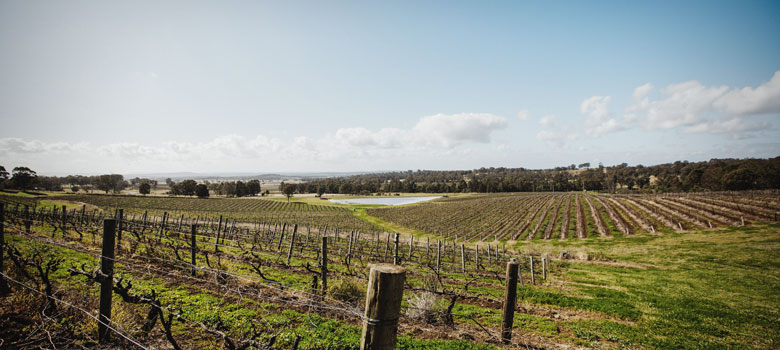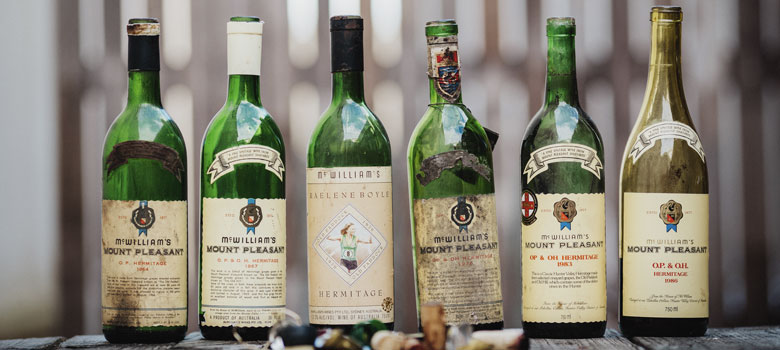
Wine
Mount Pleasant
An Australian Wine Icon
An Australian wine icon becomes becomes a centenarian this year and the wines that have flowed from its hallowed ground are now more relevant than ever.
This year sees one of Australia’s most important wine concerns, Mount Pleasant, celebrate their 100th anniversary. From their home in the Hunter Valley, this historic winery showed Australian producers what was possible with Shiraz – perhaps our most defining grape – at a time when everybody was drinking beer and fortifieds, crafting as many milestone table wines as there are candles in a centenary cake.
Left: The Mount Pleasant Winery; Right: Pouring an aged Lovedale Semillon
Beginnings of Mount Pleasant Wine
The vines on the red-earthed vineyard that overlook the Mount Pleasant winery and cellar door were planted in 1880 by Englishman Charles King. Those vines are part of a vineyard now known as the “Old Hill,” that was eventually purchased by Leontine O’Shea in 1921 on the advice of her son Maurice.
Maurice had just returned from France where he had studied as a viticulturist and chemist. During his time in France, wine had a great impact on him, particularly the wines made from Syrah (Shiraz) that came from the steep hillsides of the Rhone Valley.
Back in the Hunter, he saw the potential for grape growing in the region and was inspired to try to create the kind of wines that had grabbed his attention in France.
The O’Sheas purchased the property, extending the plantings and naming the property ‘Mount Pleasant.’
Maurice got to work and soon gained a reputation for making wines with elegance, purity and restraint. The fledgling Australian wine community started to take notice and soon inspired others as to what was possible with table wine in the new world.
He probably didn’t know it at the time, but Maurice had created what is today considered the regional style of Hunter Valley wine. His intuitive grasp of the vineyard sites and masterful blending ability had created something that not only inspired the rest of the country, but created a style of wine that has endured 100 years on. Maurice O’Shea is widely considered the ‘Grandfather of Modern Australian Wine.’
Left: The legendary Maurice O'Shea; Right: The vineyards of Mount Pleasant
A Pivotal Partnership
One Australian who had been inspired by Maurice’s wines was Keith McWilliam of McWilliam’s Wines. Then, as the depression hit and financial difficulties began to bite, Mount Pleasant began to struggle and Keith offered to buy into the business.
With the McWilliam family support, Maurice expanded Mount Pleasant adding the now iconic ‘Lovedale’ and ‘Rosehill’ sites to the estate. McWilliam’s purchased the remaining shares in 1941 and Maurice, free from the restraints of sales and distribution, was able to concentrate solely on his winemaking.
The wines he produced from the 1940s and 1950s went on to achieve legendary status.
O’Shea tragically passed away in 1956, aged just 59, but the earthy, elegant, medium-bodied wines that he created left a lasting legacy. Though few remain today, O’Shea’s wines are rare and highly sought-after.
The late great Len Evans said he got more pleasure out of O’Shea’s than any other Australian wines and Max Schubert, creator of Grange, said he ‘felt humbled’ to be in the presence of the wines of O’Shea.
The Modern Era
By the 1990s, Australian Shiraz started to boom. Some wines that were $15-$30 dollars a bottle in the 1980s started fetching close to $500 and as demand for these wines grew, particularly in America, the trend for bigger, richer, riper, oak driven Shiraz began to dominate.
Now, however, the Shiraz pendulum has swung back and people want wines with softer tannins and less ripe, sweet fruit characteristics. This has meant we are seeing wines that reflect the old Mount Pleasant ‘Hunter River Burgundy’ style of Shiraz come back into vogue. As this classic style becomes more in demand, the importance of site and vineyard characteristics become critical and the legacy of O’Shea begins to come back into focus.

Above: Some classic vintages of OP&OH
A Special Tasting of Mount Pleasant Wines
Since Maurice’s passing, there have only been four Mount Pleasant chief winemakers, meaning that for 60 percent of its history, Brian Walsh, Phil Ryan, Jim Chatto and Adrian Sparks have carried on this important legacy.
This 100-year legacy and the sites that uphold it were on clear display at a ‘Toast to Mount Pleasant,’ tasting co-chaired by ex-chief winemaker Phil Ryan and current chief Adrian Sparks. The tasting was a unique opportunity to reflect on Maurice’s legacy through a special range of rarely seen wines.
Starting with Mount Pleasant’s flagship white, Lovedale, going back to 1986, the wines highlighted there hasn’t been much change from the classic Hunter Semillon script of the past 34 years. “Lovedale is special because it has a finesse and elegance that some of the other great Hunter Semillon sites don’t have,” notes Adrian. “To me, the other sites are richer, have more fruit weight, whereas I think Lovedale is more aromatic with a finer, lighter palate. I think it is because the soils are a little sandier.
Lovedale has always ranked amongst the best Semillon in the world and from the poise and structure of the 1986, to the clean and precise palate of the 1996 to the incredibly fresh, complex and vibrant wines of 2011 and 2013, this isn’t likely to change any time soon.
Left: Ex-chief winemaker Phil Ryan and current chief winemaker Adrian Sparks; Right: New Mount Pleasant plantings
Sites Devine
The OP and OH, ‘Old Paddock and Old Hill’ range is a blend of the original 1880 Old Hill and the 1921 O’Shea planted Old Paddock vines. The fruit is as complex and brooding as it is steeped in history. The bracket reinforced the contribution of site and style to create wines that are character driven with the ability to last well beyond four decades.
“It’s almost the perfect site,” explains Adrian of the OP and OH vineyards. “It’s sheltered from all the wind and harsh afternoon sun and the morning sun hits it and dries it out beautifully, and because of that, it retains all its tannin and acidity.”
On tasting, it’s clear that the acid structure, and mid-weighted style of these wines, are keys to graceful, structured aging, as highlighted by the immense concentration and creamy depth to the Pinot-like 1964 vintage wine. The theme continued all the way through the wines from the 1970s and 1980s with fine, leathery fruit layers defining wines of incredible character and complexity with silky mouthfeels. The younger wines, which include the 1995, 1998, to the current vintages were incredibly fresh, displaying differing variations on concentrated red and black fruit energy, lift and character.
Left: Mount Pleasant Chief Winemaker Adrian Sparks; Right: The ancient Old Hill vineyard
Namesakes
Lastly, a flight of O’Shea wines rounded out an epic tasting experience. Started in 1987 and only made in good years, these flagship wines are crafted from selected parcels of fruit from the OP, OH and Rosehill vineyards that highlight the best of each vintage. These wines are characterised by power, balance, perfume and spice, but retaining the classic hallmark Hunter style that O’Shea defined.
The wines are simply incredible with long, concentrated palates, superfine tannins and ethereal layers of red and black fruited aromatics and that earthy Hunter signature. The 1987 is one of the true great wines and whilst some of the late 90s and 2000s wines had more obvious oak, the wines are too good to be critical of. The 2014 and 2017 were babies in the scheme of things, but showed impressive character and promise.
Adrian is conscious of the weight that comes with caring for the O’Shea legacy, and making the wine that bears his name. “I was judging at the NSW wine awards in 2009 and someone had brought along a 47 or a 49 O’Shea wine,” he recalls. “As the group tasted and talked, I started to realise how important O’Shea and Mount Pleasant were to the landscape of Australian wine.”
The Hunter is small comparatively and represents only two percent of Australian wine produced, but when you look at history and the contribution of that two percent, you soon realise how important O’Shea is in the Australian wine industry.